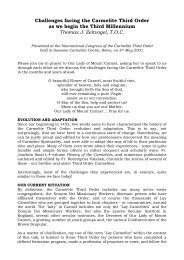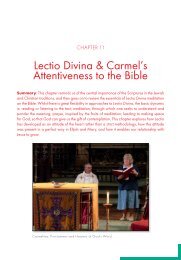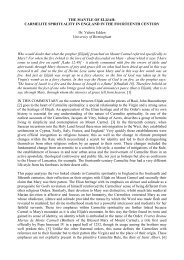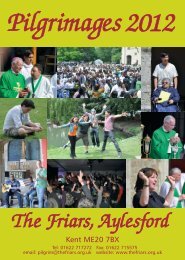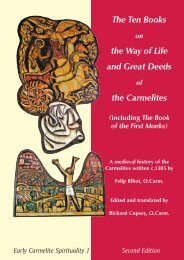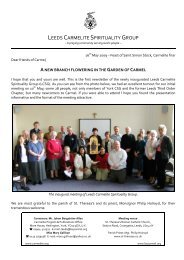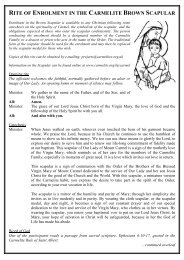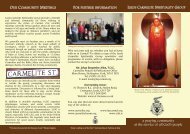Saint Albert of Trapani - British Province of Carmelite Friars
Saint Albert of Trapani - British Province of Carmelite Friars
Saint Albert of Trapani - British Province of Carmelite Friars
You also want an ePaper? Increase the reach of your titles
YUMPU automatically turns print PDFs into web optimized ePapers that Google loves.
historic “vascelluzzo” which came to the city through the intercession <strong>of</strong> the<br />
saint, and a flowing banner inviting the city to rejoice in having so great a<br />
protector.<br />
There are cycles which depict scenes from the life <strong>of</strong> the saint, including<br />
notable ones in Antequera in Spain, Forlì and Rome. The paintings in the<br />
choir in Antequera are the work <strong>of</strong> an eclectic 17 th –century painter from<br />
Seville influenced by Roelas, Pacheco and Herrera. They depict the saint’s<br />
reception <strong>of</strong> the <strong>Carmelite</strong> habit, his death, and his burial. Among these<br />
pictures the one <strong>of</strong> the saint’s death while he is supported by his brothers is<br />
very evocative and dramatic.<br />
The second <strong>of</strong> these cycles in the chapel <strong>of</strong> <strong>Saint</strong> <strong>Albert</strong> in the Carmine <strong>of</strong><br />
Forlì, shows <strong>Saint</strong> <strong>Albert</strong> healing a blind man on the altarpiece, in the style<br />
<strong>of</strong> Giuseppe Marchetti (1722–1801), even though it has been attributed to<br />
Paolo Cignani. Another two miracles are depicted in the ovals above the<br />
doors, attributed to Antonio Fanzaresi, who painted them in 1752. The first<br />
shows <strong>Saint</strong> <strong>Albert</strong> as he miraculously makes supplies arrive in the besieged<br />
Messina, while the second presents him as he saves some shipwrecked Jews,<br />
who then convert to Christianity.<br />
The third cycle is the one in the chapel dedicated to the saint in the church<br />
<strong>of</strong> Traspontina in Rome, which the prior general Sebastiano Fantoni had<br />
decorated at the beginning <strong>of</strong> the 17 th century. The altarpiece represents the<br />
saint standing with a lily in his right hand and a glory <strong>of</strong> angels above his<br />
head, and is the work <strong>of</strong> Antonio Pomarancio (1570-c.1630). In the octagon<br />
at the centre <strong>of</strong> the vault the same artist has painted the saint’s birth, and in<br />
the side panels some scenes from his life, his vesting on the right and a<br />
miracle on the left. On the side walls Pomarancio continued the scenes from<br />
<strong>Albert</strong>’s life in two large frescoes depicting his preaching and his death.<br />
There are also notable cycles in the <strong>Carmelite</strong> churches <strong>of</strong> Venice and<br />
Brescia, and in the cloisters <strong>of</strong> the convents <strong>of</strong> Verona and Lugo.



